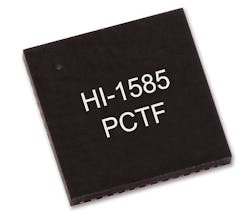MIL-STD-1553 avionics databus interface with tail-off compensation introduced by Holt
MISSION VIEJO, Calif., 8 Jan. 2016. Holt Integrated Circuits in Mission Viejo, Calif., is introducing the HI-1585 MIL-STD-1553 dual transceiver avionics databus interface with tail-off compensation.
MIL-STD-1553 bus tail-off or offset is a transmitter-induced phenomenon caused by imbalance in the transmit signal path. It causes a temporary DC offset on the terminal's bus stub which can temporarily impair the terminal's ability to decode received commands following transmission of long messages.
The device provides two options to compensate for transmitter-induced tail-off, namely input data synchronization and programmable tail-off adjustment. The former enables a clocked input for the logic-level transmit signal pair to provide precise synchronization and mitigate input signal timing differences.
The latter option provides a means for digitally tuning tail-off characteristics for problem designs that fail to meet "output symmetry" (tail-off) requirements, usually a result of non-optimal board design and layout. Compensation is pin-selected and bus-specific. Three adjustment levels are provided for either polarity, reducing tail-off amplitude up to ±100 millivolts DC.
Related: API for MIL-STD-1553 integrated terminal devices introduced by Holt Integrated Circuits
In addition to bus tail-off compensation, the HI-1585 also has an optional receiver output pulse extension. This ensures minimum receive output pulse width of 300 nanoseconds, even when the receiver differential input signals are close to the MIL-STD-1553 minimum receiver input response amplitude of 860 mVpp for a transformer-coupled bus.
The HI-1585 is packaged in a 48-pin plastic 6-by-6-millimeter QFN with an exposed heat sink pad, which may be soldered to the circuit board ground plane for optimal thermal dissipation.
The device is available in industrial versions that operate in temperatures form -40 to 85 degrees Celsius, or in extended-temperature versions that operate from -55 to 125 C, with optional burn-in available on the extended temperature range.
For more information contact Holt Integrated Circuits online at www.holtic.com.
